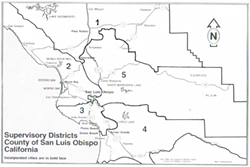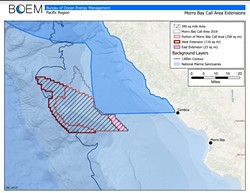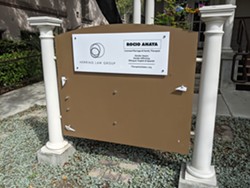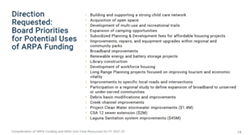Tuesday, July 13, 2021
SLO County to hold first redistricting hearing on July 20
Posted By Peter Johnson on Tue, Jul 13, 2021 at 11:13 AM
The San Luis Obispo County Board of Supervisors is kicking off its once-a-decade redistricting process with a public hearing on July 20.
Residents will have their first chance to weigh in on the redrawing of five supervisorial districts by attending the 1:30 p.m. meeting at the county government center or submitting a comment or map at slocounty.ca.gov/redistricting.
The hearing will “solicit ideas on how to adjust the district boundaries for electing the Board of Supervisors for the next decade,” according to a county press release.
“Residents have the opportunity to provide input on what kind of boundaries should be drawn to best represent their community,” it reads.
It’s the first of five hearings planned on redistricting between July 20 and Dec. 14, when the Board of Supervisors will adopt the final map, which lasts until 2031.
Earlier this year, supervisors opted not to form an independent redistricting commission for the task. They’ll instead rely on county staff and consultants to shepherd the process while making a final decision about the map.
The upcoming hearing will take place without access to 2020 Census data, which is delayed due to COVID-19 and won’t be available until September or October.
Census data is needed to draw accurate districts of equal populations, in compliance with the Voting Rights Act and other requirements.
Despite the lack of access to Census data, county officials are inviting residents to use an online mapping tool to submit proposed maps based on older data.
Future county redistricting meetings are scheduled for Oct. 26, Nov. 19, Nov. 30, and Dec. 14. ∆
Residents will have their first chance to weigh in on the redrawing of five supervisorial districts by attending the 1:30 p.m. meeting at the county government center or submitting a comment or map at slocounty.ca.gov/redistricting.
The hearing will “solicit ideas on how to adjust the district boundaries for electing the Board of Supervisors for the next decade,” according to a county press release.
“Residents have the opportunity to provide input on what kind of boundaries should be drawn to best represent their community,” it reads.
It’s the first of five hearings planned on redistricting between July 20 and Dec. 14, when the Board of Supervisors will adopt the final map, which lasts until 2031.
Earlier this year, supervisors opted not to form an independent redistricting commission for the task. They’ll instead rely on county staff and consultants to shepherd the process while making a final decision about the map.
The upcoming hearing will take place without access to 2020 Census data, which is delayed due to COVID-19 and won’t be available until September or October.
Census data is needed to draw accurate districts of equal populations, in compliance with the Voting Rights Act and other requirements.
Despite the lack of access to Census data, county officials are inviting residents to use an online mapping tool to submit proposed maps based on older data.
Future county redistricting meetings are scheduled for Oct. 26, Nov. 19, Nov. 30, and Dec. 14. ∆
—Peter Johnson
Thursday, July 8, 2021
Lompoc consolidates cannabis tax election with governor recall vote
Posted By Malea Martin on Thu, Jul 8, 2021 at 12:21 PM
Lompoc city residents will have a chance to vote on proposed changes to the city’s cannabis tax on Sept. 14, rather than Aug. 31 as was originally planned. The city voted to consolidate the cannabis tax election with the vote to recall Gov. Gavin Newsom, a move that will save Lompoc nearly $200,000 and allow people to vote by mail or in person.
The cannabis tax changes, if voted through, would “impose tiered taxes on cannabis manufacturing and distribution operators, change how all cannabis taxes are calculated, and allow those taxes to be shown on customer receipts,” City Attorney Jeff Malawy said at a July 5 special meeting.
“The legislature did pass a bill Thursday [July 1], we found out about it late Thursday afternoon, that the recall was then set for Sept. 14,” City Manager Jim Throop said at the special meeting. “We were still going to go with our Aug. 31 date as the council approved.”
But, the consulting firms that Lompoc was planning to use for its special election—firms that the county has used in the past—“had backed out earlier when they heard the recall was coming up,” Throop explained. The city would have had to wait until November to hold the special election using the county’s consultants, and it would have been more costly.
Lucky for Lompoc, there’s another option.
“On this bill that was signed, they attached a rider, and that rider said, any city that called a special election prior to June 15, which is us, you can then consolidate with the county and be part of that election for the recall,” Throop said.
But, he continued, the state legislation only gave the city four days to approve this change, hence the last minute special meeting.
If the city opted to do a separate special election in November, it would have cost about $250,000. But consolidating it with the county-run recall ballot will bring it “back to a normal cost of about $65,000,” Throop said.
“The best thing [is] we’re having the county do it,” he added. “They’re professionals, they do this all the time, they know how to run an election, they know how to count the ballots and get everything done.”
Another benefit of combining the elections is that people can vote by mail or in person. If the special election had been separate, it would have been mail-in only.
Despite the meeting being called at the last minute, a few community members showed up to give public comments, all of whom were in favor of combining the elections. The resolution to consolidate the elections passed unanimously. Δ
The cannabis tax changes, if voted through, would “impose tiered taxes on cannabis manufacturing and distribution operators, change how all cannabis taxes are calculated, and allow those taxes to be shown on customer receipts,” City Attorney Jeff Malawy said at a July 5 special meeting.
“The legislature did pass a bill Thursday [July 1], we found out about it late Thursday afternoon, that the recall was then set for Sept. 14,” City Manager Jim Throop said at the special meeting. “We were still going to go with our Aug. 31 date as the council approved.”
But, the consulting firms that Lompoc was planning to use for its special election—firms that the county has used in the past—“had backed out earlier when they heard the recall was coming up,” Throop explained. The city would have had to wait until November to hold the special election using the county’s consultants, and it would have been more costly.
Lucky for Lompoc, there’s another option.
“On this bill that was signed, they attached a rider, and that rider said, any city that called a special election prior to June 15, which is us, you can then consolidate with the county and be part of that election for the recall,” Throop said.
But, he continued, the state legislation only gave the city four days to approve this change, hence the last minute special meeting.
If the city opted to do a separate special election in November, it would have cost about $250,000. But consolidating it with the county-run recall ballot will bring it “back to a normal cost of about $65,000,” Throop said.
“The best thing [is] we’re having the county do it,” he added. “They’re professionals, they do this all the time, they know how to run an election, they know how to count the ballots and get everything done.”
Another benefit of combining the elections is that people can vote by mail or in person. If the special election had been separate, it would have been mail-in only.
Despite the meeting being called at the last minute, a few community members showed up to give public comments, all of whom were in favor of combining the elections. The resolution to consolidate the elections passed unanimously. Δ
—Karen Garcia
Wednesday, June 30, 2021
Porter sentenced to 285 years for child sex crimes
Posted By Peter Johnson on Wed, Jun 30, 2021 at 4:01 PM
Convicted child abuser Jason Porter of Paso Robles received a 285-year prison sentence in court on June 28, concluding a five-year criminal case with many child victims.
SLO County Superior Court Judge Barry LaBarbera handed down the sentence, agreeing with prosecutors that Porter, 49, should face separate sentences for each of his 16 felony sex crimes, which involved the abuse of young children, ages one to 13, and possession of child pornography.
In a statement released after the sentencing, SLO County District Attorney Dan Dow applauded “the courage of these young survivors in reporting the abuse, and the parents of the survivors who appeared in court today to face the defendant and express the very real impact of his terrible crimes.”
Deputy DA Melissa Chabra, who prosecuted the case as part of the DA’s Office’s Sexual Assault and Child Abuse Unit, said the sentencing “finally deliver[s] justice to all of the survivors involved.”
Porter, who waived his right to a jury trial, was found guilty on June 2 of more than 52 felony and misdemeanor crimes.
Held in SLO County jail on $7 million bail since his arrest in 2016, Porter will soon be transferred to the California Department of Corrections and Rehabilitation for placement in state prison.
SLO County Superior Court Judge Barry LaBarbera handed down the sentence, agreeing with prosecutors that Porter, 49, should face separate sentences for each of his 16 felony sex crimes, which involved the abuse of young children, ages one to 13, and possession of child pornography.
In a statement released after the sentencing, SLO County District Attorney Dan Dow applauded “the courage of these young survivors in reporting the abuse, and the parents of the survivors who appeared in court today to face the defendant and express the very real impact of his terrible crimes.”
Deputy DA Melissa Chabra, who prosecuted the case as part of the DA’s Office’s Sexual Assault and Child Abuse Unit, said the sentencing “finally deliver[s] justice to all of the survivors involved.”
Porter, who waived his right to a jury trial, was found guilty on June 2 of more than 52 felony and misdemeanor crimes.
Held in SLO County jail on $7 million bail since his arrest in 2016, Porter will soon be transferred to the California Department of Corrections and Rehabilitation for placement in state prison.
—Peter Johnson
Tuesday, June 22, 2021
SLO County passes resolution in support of offshore wind plans
Posted By Peter Johnson on Tue, Jun 22, 2021 at 1:02 PM
San Luis Obispo County is now on record supporting federal and state initiatives to develop a wind farm off the coast of Morro Bay.
On June 22, the Board of Supervisors adopted a resolution backing the clean energy plans, a move that will signal the county’s interest in receiving funds to conduct local feasibility and impact studies, officials said.
“The funds are there now to have these feasibility studies,” 3rd District Supervisor Dawn Ortiz-Legg said. “We need to get into the mix.”
Passed on a 4-0 vote, the resolution registered the county’s support for offshore wind, advocated for state and federal funding to study what it’d take to create a “clean energy port” in SLO County, and called for an analysis of economic impacts to the commercial fishing industry.
It comes just a few weeks after federal and state authorities unveiled a new agreement on plans to develop a 399-square-mile wind farm off the coast of Morro Bay, with the potential to produce 3 gigawatts of energy.
According to the resolution, an offshore wind farm could create about 12,000 construction jobs over five years and up to 650 operations and maintenance jobs annually.
The resolution also recognized the importance of the commercial fishing industry to the Central Coast—and its vulnerability to any offshore wind development, a response to recent criticism from fishing groups about their lack of input or consideration.
"The Central Coast commercial fishing fleet contributes to the economy, quality of life, and culture of the region, the county commits to collaborate with the fleet regarding policies that may affect commercial fishing,” it reads.
Fifth District Supervisor Debbie Arnold abstained from the vote, stating that she wasn’t yet comfortable voicing her support or opposition to the wind energy initiatives.
“To sign my name on a resolution … seems a little premature,” Arnold said. “I don’t have the information, much information at all, to be able to make that statement that I support all of these things.” ∆
On June 22, the Board of Supervisors adopted a resolution backing the clean energy plans, a move that will signal the county’s interest in receiving funds to conduct local feasibility and impact studies, officials said.
“The funds are there now to have these feasibility studies,” 3rd District Supervisor Dawn Ortiz-Legg said. “We need to get into the mix.”
Passed on a 4-0 vote, the resolution registered the county’s support for offshore wind, advocated for state and federal funding to study what it’d take to create a “clean energy port” in SLO County, and called for an analysis of economic impacts to the commercial fishing industry.
It comes just a few weeks after federal and state authorities unveiled a new agreement on plans to develop a 399-square-mile wind farm off the coast of Morro Bay, with the potential to produce 3 gigawatts of energy.
According to the resolution, an offshore wind farm could create about 12,000 construction jobs over five years and up to 650 operations and maintenance jobs annually.
The resolution also recognized the importance of the commercial fishing industry to the Central Coast—and its vulnerability to any offshore wind development, a response to recent criticism from fishing groups about their lack of input or consideration.
"The Central Coast commercial fishing fleet contributes to the economy, quality of life, and culture of the region, the county commits to collaborate with the fleet regarding policies that may affect commercial fishing,” it reads.
Fifth District Supervisor Debbie Arnold abstained from the vote, stating that she wasn’t yet comfortable voicing her support or opposition to the wind energy initiatives.
“To sign my name on a resolution … seems a little premature,” Arnold said. “I don’t have the information, much information at all, to be able to make that statement that I support all of these things.” ∆
—Peter Johnson
Wednesday, June 16, 2021
Santa Maria repeals H-2A housing ordinance to avoid federal fine, litigation
Posted By Malea Martin on Wed, Jun 16, 2021 at 4:00 PM
The Santa Maria City Council reluctantly voted to repeal its employee housing ordinance on June 15 after the U.S. Department of Housing and Urban Development said it may be discriminatory and that the city could incur a $400,000 fine if the council did not repeal it.
Director of Community Development Chuen Ng said at the meeting that HUD’s Office of Fair Housing and Equal Opportunity first opened its investigation into the city’s ordinance in April 2020. This was followed up by a HUD secretary initiated complaint in August 2020.
“The complaint alleges that the city unlawfully discriminated because of race, color, or national origin by restricting housing for H-2A farmworker visa holders within the city, in violation of the Fair Housing Act,” Ng said. “After further investigation and review, the city received in May 2021 a consent proposal … from HUD, which had determined that the city must repeal and not enforce its employee housing ordinance.”
First adopted in June 2019, the ordinance permits employee housing in multi-family zones, but requires a conditional use permit in single family zones. HUD alleged that regulating which zones H-2A workers can live in amounts to a “restriction of housing for people from a specific foreign country or national origin, defined as a federally protected class, and may be discriminatory,” Ng explained.
HUD offered the city a voluntary compliance agreement, which the city council voted in favor of 3-2 on June 15. This agreement means the city will no longer enforce its employee housing ordinance, and HUD will not levy a fine or pursue legal action against the city.
Ng said that the agreement does not act as a “final finding or a determination by HUD that the city intentionally engaged in unlawful practices.”
City Attorney Thomas Watson said he does not agree with HUD’s initial determination that the city’s ordinance may be discriminatory. But, he cautioned, if the city didn’t sign on to the voluntary compliance agreement, the fine might have been even steeper than $400,000.
If the city hadn’t repealed it, there was “potential that a court would make a finding that the city inadvertently or intentionally was discriminatory, which I do not believe and which we deny emphatically,” Watson said. “And this agreement does not make such a finding.”
For this reason, he and city staff supported adopting the agreement. During the public hearing portion of the meeting, former Santa Maria City Attorney Philip Sinco, the principal author of the ordinance, said he does not believe it is discriminatory as it “only applies to employers who provide housing to their employees,” not individual persons.
“I’m not speaking in support or opposition to staff’s recommendation. I fully understand the recommendation and the reasons for it,” he said. “I’m only speaking as to my personal position that the city’s ordinance does not violate any state or federal laws.”
Councilmember Michael Cordero said he does not agree with HUD’s discrimination allegations, but he voted to repeal the ordinance because, in his words, “We don’t have much of a choice in this matter.”
“I disagree in the sense that there’s anything that we did as a council that represents anything remotely close to being against any segment of the community, of which the H-2A workers are a very important part of,” Cordero said. “We took input from all the stakeholders over a long period of time in various places in the community in order to do the best job that we possibly could.”
Cordero and Councilmembers Gloria Soto and Carlos Escobedo each voted to repeal the ordinance and adhere to HUD’s voluntary compliance agreement, while Mayor Alice Patino and Councilmember Etta Waterfield voted no.
“We live here,” Waterfield said before the vote. “We understand our neighbors, we understand what they’re going through, and when we make a decision, it gets undermined by the state or by the feds. And so I’m just really disappointed with this action.” Δ
Director of Community Development Chuen Ng said at the meeting that HUD’s Office of Fair Housing and Equal Opportunity first opened its investigation into the city’s ordinance in April 2020. This was followed up by a HUD secretary initiated complaint in August 2020.
“The complaint alleges that the city unlawfully discriminated because of race, color, or national origin by restricting housing for H-2A farmworker visa holders within the city, in violation of the Fair Housing Act,” Ng said. “After further investigation and review, the city received in May 2021 a consent proposal … from HUD, which had determined that the city must repeal and not enforce its employee housing ordinance.”
First adopted in June 2019, the ordinance permits employee housing in multi-family zones, but requires a conditional use permit in single family zones. HUD alleged that regulating which zones H-2A workers can live in amounts to a “restriction of housing for people from a specific foreign country or national origin, defined as a federally protected class, and may be discriminatory,” Ng explained.
HUD offered the city a voluntary compliance agreement, which the city council voted in favor of 3-2 on June 15. This agreement means the city will no longer enforce its employee housing ordinance, and HUD will not levy a fine or pursue legal action against the city.
Ng said that the agreement does not act as a “final finding or a determination by HUD that the city intentionally engaged in unlawful practices.”
City Attorney Thomas Watson said he does not agree with HUD’s initial determination that the city’s ordinance may be discriminatory. But, he cautioned, if the city didn’t sign on to the voluntary compliance agreement, the fine might have been even steeper than $400,000.
If the city hadn’t repealed it, there was “potential that a court would make a finding that the city inadvertently or intentionally was discriminatory, which I do not believe and which we deny emphatically,” Watson said. “And this agreement does not make such a finding.”
For this reason, he and city staff supported adopting the agreement. During the public hearing portion of the meeting, former Santa Maria City Attorney Philip Sinco, the principal author of the ordinance, said he does not believe it is discriminatory as it “only applies to employers who provide housing to their employees,” not individual persons.
“I’m not speaking in support or opposition to staff’s recommendation. I fully understand the recommendation and the reasons for it,” he said. “I’m only speaking as to my personal position that the city’s ordinance does not violate any state or federal laws.”
Councilmember Michael Cordero said he does not agree with HUD’s discrimination allegations, but he voted to repeal the ordinance because, in his words, “We don’t have much of a choice in this matter.”
“I disagree in the sense that there’s anything that we did as a council that represents anything remotely close to being against any segment of the community, of which the H-2A workers are a very important part of,” Cordero said. “We took input from all the stakeholders over a long period of time in various places in the community in order to do the best job that we possibly could.”
Cordero and Councilmembers Gloria Soto and Carlos Escobedo each voted to repeal the ordinance and adhere to HUD’s voluntary compliance agreement, while Mayor Alice Patino and Councilmember Etta Waterfield voted no.
“We live here,” Waterfield said before the vote. “We understand our neighbors, we understand what they’re going through, and when we make a decision, it gets undermined by the state or by the feds. And so I’m just really disappointed with this action.” Δ
—Malea Martin
Thursday, June 10, 2021
Santa Maria high school student elected as state FFA's president
Posted By Malea Martin on Thu, Jun 10, 2021 at 1:05 PM
Despite the challenges of distance learning, especially for a hands-on program like agriculture, Santa Maria Joint Union High School District’s agriculture students won awards and recognition in state-level career development events, and Pioneer Valley High School students excelled at the California State FFA Leadership Conference.
“This whole year has been such a great challenge, having to transition nearly everything that we do in our programs into a virtual format,” PVHS agriculture teacher Tyler Dickinson said. “FFA is a very hands-on, experiential learning type of program where students have the ability to get their hands dirty and learn some skills that translate into a career.”
But PVHS students found a way to make it work, and still get that hands-on ag experience outside of the classroom.
“Before the reopening, [Chapter President] Marc Cabeliza and the rest of the leadership team, they’ve worked really hard trying to engage the community with drive-through events and giveaways, and providing fresh produce to over 1,000 families in the community,” Dickinson said. “At The Patch, Marc had given out over 500 boxes of strawberries to the community.”
Cabeliza, along with three other PVHS FFA students, won recognition for their Specialized Agricultural Experience (SAE) projects at the California State FFA Leadership Conference last month. Cabeliza has worked with The Patch Santa Maria, which gives local students leadership and agricultural opportunities through pumpkin and corn growing programs, for the last three years. He was named the state winner in the SAE area of service learning for his dedication to The Patch, and also elected to be the California State FFA President.
“He will be taking a year off [before] college, and he will be kind of an advocate for the agriculture industry and working with the industry, and putting on leadership conferences,” Dickinson said of Cabeliza’s presidential role. “He’s going to be a representative for the entire state association, which is over 95,000 FFA members here in California.”
PVHS, Santa Maria High School, and Righetti High School students all placed in various career development events at the state level as well. PVHS student Hannah Limon was the state champion for soil and land evaluation, the team that Dickinson coaches.
“Despite the societal challenges that we’ve had,” Dickinson said, “Pioneer Valley has definitely soared over this past year and has become resilient, and embraced those challenges.” Δ
“This whole year has been such a great challenge, having to transition nearly everything that we do in our programs into a virtual format,” PVHS agriculture teacher Tyler Dickinson said. “FFA is a very hands-on, experiential learning type of program where students have the ability to get their hands dirty and learn some skills that translate into a career.”
But PVHS students found a way to make it work, and still get that hands-on ag experience outside of the classroom.
“Before the reopening, [Chapter President] Marc Cabeliza and the rest of the leadership team, they’ve worked really hard trying to engage the community with drive-through events and giveaways, and providing fresh produce to over 1,000 families in the community,” Dickinson said. “At The Patch, Marc had given out over 500 boxes of strawberries to the community.”
Cabeliza, along with three other PVHS FFA students, won recognition for their Specialized Agricultural Experience (SAE) projects at the California State FFA Leadership Conference last month. Cabeliza has worked with The Patch Santa Maria, which gives local students leadership and agricultural opportunities through pumpkin and corn growing programs, for the last three years. He was named the state winner in the SAE area of service learning for his dedication to The Patch, and also elected to be the California State FFA President.
“He will be taking a year off [before] college, and he will be kind of an advocate for the agriculture industry and working with the industry, and putting on leadership conferences,” Dickinson said of Cabeliza’s presidential role. “He’s going to be a representative for the entire state association, which is over 95,000 FFA members here in California.”
PVHS, Santa Maria High School, and Righetti High School students all placed in various career development events at the state level as well. PVHS student Hannah Limon was the state champion for soil and land evaluation, the team that Dickinson coaches.
“Despite the societal challenges that we’ve had,” Dickinson said, “Pioneer Valley has definitely soared over this past year and has become resilient, and embraced those challenges.” Δ
—Malea Martin
Tuesday, June 8, 2021
Marian hospital opens behavioral health unit
Posted By Peter Johnson on Tue, Jun 8, 2021 at 4:20 PM
On June 8, Marian Regional Medical Center in Santa Maria opened its first behavioral health unit, which hospital leaders say fills an urgent and unmet need in the community.
The eight-chair behavioral health unit will be open 24 hours a day to provide “intervention, assessment, evaluation, therapy, and support for those experiencing a mental health crisis,” according to a Marian press release.
Because of the unit, which will be staffed by psychiatrists and psychiatric nurses, Marian says it can now quickly transfer patients there from its emergency room, rather than wait for openings at out-of-area mental health facilities.
“With one out of every eight emergency department visits being behavioral health or substance abuse related, the behavioral health outpatient unit will fill an incredible void in local health care,” Marian’s press release read. “[The unit] will see patients as soon as they are medically cleared, providing early treatment initiation.”
For now, Marian’s new unit will only serve patients at the Santa Maria hospital, but it could potentially expand in the “near future” to serve those in San Luis Obispo County, according to spokesperson Sara San-Juan.
The hospital’s press release stated that Santa Barbara County currently has only four inpatient mental health beds for every 100,000 residents, when the medically recommended number is 50 beds per 100,000 residents.
David Ketelaar, an emergency physician at Marian hospital, said that the need for services is growing in the wake of the COVID-19 pandemic.
“Mental health conditions were increasing in all age groups prior to the COVID-19 pandemic. The pandemic has accelerated this increase dramatically,” Ketelaar said. “We are committed to supporting local behavioral health services to meet the needs of our community.” ∆
The eight-chair behavioral health unit will be open 24 hours a day to provide “intervention, assessment, evaluation, therapy, and support for those experiencing a mental health crisis,” according to a Marian press release.
Because of the unit, which will be staffed by psychiatrists and psychiatric nurses, Marian says it can now quickly transfer patients there from its emergency room, rather than wait for openings at out-of-area mental health facilities.
“With one out of every eight emergency department visits being behavioral health or substance abuse related, the behavioral health outpatient unit will fill an incredible void in local health care,” Marian’s press release read. “[The unit] will see patients as soon as they are medically cleared, providing early treatment initiation.”
For now, Marian’s new unit will only serve patients at the Santa Maria hospital, but it could potentially expand in the “near future” to serve those in San Luis Obispo County, according to spokesperson Sara San-Juan.
The hospital’s press release stated that Santa Barbara County currently has only four inpatient mental health beds for every 100,000 residents, when the medically recommended number is 50 beds per 100,000 residents.
David Ketelaar, an emergency physician at Marian hospital, said that the need for services is growing in the wake of the COVID-19 pandemic.
“Mental health conditions were increasing in all age groups prior to the COVID-19 pandemic. The pandemic has accelerated this increase dramatically,” Ketelaar said. “We are committed to supporting local behavioral health services to meet the needs of our community.” ∆
—Peter Johnson
Monday, June 7, 2021
Skipper’s rallies to help GALA replace sign stolen as Pride month started
Posted By Karen Garcia on Mon, Jun 7, 2021 at 10:16 AM
Skipper’s Brew Coffee House in San Luis Obispo is donating 100 percent of its sales today, June 7, to the GALA Pride and Diversity Center.
Skipper’s posted their efforts on Instagram, calling on its customers to support the GALA center after its office sign was stolen sometime between May 30 and June 2.
“We are all family, and we are all in this together,” the post read.
The incident occured at the start of Pride month, celebrated during the month of June.
GALA board president Doug Heumann said the organization is disappointed that someone “would feel the need to act out in this way.”
“The LGBTQI-plus community feels supported in this county, but the vandalism is a reminder that we’ve still got work to do,” Heumann said in a statement.
Located at 1080 Palm Ave. in San Luis Obispo, GALA shares a building with the Herring Law Group. While the law group’s sign is intact, only pieces of GALA’s sign remain attached to the screws that once held it.
GALA Coordinator Serrina Ruggles is asking the community for help in making temporary yard signs and colorful banners to decorate the building during Pride month.
“We’d like to have the colors of Pride filling the front of our building. I’m hoping we can make this a rallying point for solidarity and support,” Ruggles said.
Community members who are interested in donating towards a sign replacement can visit GALA’s Facebook page for a Paypal link to leave monetary support. ∆
Skipper’s posted their efforts on Instagram, calling on its customers to support the GALA center after its office sign was stolen sometime between May 30 and June 2.
“We are all family, and we are all in this together,” the post read.
The incident occured at the start of Pride month, celebrated during the month of June.
GALA board president Doug Heumann said the organization is disappointed that someone “would feel the need to act out in this way.”
“The LGBTQI-plus community feels supported in this county, but the vandalism is a reminder that we’ve still got work to do,” Heumann said in a statement.
Located at 1080 Palm Ave. in San Luis Obispo, GALA shares a building with the Herring Law Group. While the law group’s sign is intact, only pieces of GALA’s sign remain attached to the screws that once held it.
GALA Coordinator Serrina Ruggles is asking the community for help in making temporary yard signs and colorful banners to decorate the building during Pride month.
“We’d like to have the colors of Pride filling the front of our building. I’m hoping we can make this a rallying point for solidarity and support,” Ruggles said.
Community members who are interested in donating towards a sign replacement can visit GALA’s Facebook page for a Paypal link to leave monetary support. ∆
—Karen Garcia
Friday, June 4, 2021
Santa Barbara council member selected to represent Central Coast on Coastal Commission
Posted By Peter Johnson on Fri, Jun 4, 2021 at 3:17 PM
Gov. Gavin Newsom recently selected Santa Barbara City Councilmember Meagan Harmon to represent the South Central Coast on the California Coastal Commission, beating out several other well-known elected officials from the tri-counties region.
On May 4, Newsom’s press office announced Harmon’s appointment to the Coastal Commission, a decision that came after Harmon was nominated for the position by groups of elected officials in San Luis Obispo, Santa Barbara, and Ventura counties.
“I want to congratulate Commissioner Meagan Harmon on her new role,” Grover Beach Mayor Jeff Lee wrote in a statement to New Times. “I feel that she has an understanding of local issues important to Grover Beach, such as the Oceano Dunes and Diablo Canyon closures. Regarding the dunes, we look forward to working with her, Coastal staff, State Parks and the entire Commission to ensure that the beach is available for the safe enjoyment by residents and visitors to Grover Beach.”
Harmon is a Lompoc native, a Democrat, and has served on the Santa Barbara City Council since February 2019. She’s been a real estate law associate for years, and she works with the California League of Cities, where she serves as the first vice president of the Channel Cities Division and as a member of the Housing Community and Economic Development Policy Committee.
"As a real estate and land-use lawyer, I do understand how challenging it can be to work at the intersection of the Coastal Act and private property rights, and I understand how important it is that we're sensitive to both," Harmon said at a SLO County Board of Supervisors meeting on March 16. "I love our coast. I'm committed to protecting it, but it's also vital that we move beyond entrenchment to all the problems of our time. I wrote about this in my letter, but issues like affordable housing, like job creation, these are connected to the Coastal Commission."
The California Coastal Commission is made up of 12 voting members and three non-voting members charged with regulating land and water use on the coast. All voting members are appointed to the Coastal Commission by the governor, the Senate Rules Committee, or the speaker of the Assembly, and half of the voting members are local elected officials in specific coastal districts.
In 2014, former Gov. Jerry Brown appointed former Pismo Beach City Councilmember Erik Howell to the commission to represent the South Central Coast, which consists of SLO, Santa Barbara, and Ventura counties. Howell served on the Coastal Commission until he lost his bid for reelection to the Pismo Beach City Council in November 2020, leaving the South Central Coast seat up for grabs.
Harmon was chosen for the position out of several other nominees, including Morro Bay Mayor John Headding and Santa Barbara County 1st District Supervisor Das Williams. ∆
On May 4, Newsom’s press office announced Harmon’s appointment to the Coastal Commission, a decision that came after Harmon was nominated for the position by groups of elected officials in San Luis Obispo, Santa Barbara, and Ventura counties.
“I want to congratulate Commissioner Meagan Harmon on her new role,” Grover Beach Mayor Jeff Lee wrote in a statement to New Times. “I feel that she has an understanding of local issues important to Grover Beach, such as the Oceano Dunes and Diablo Canyon closures. Regarding the dunes, we look forward to working with her, Coastal staff, State Parks and the entire Commission to ensure that the beach is available for the safe enjoyment by residents and visitors to Grover Beach.”
Harmon is a Lompoc native, a Democrat, and has served on the Santa Barbara City Council since February 2019. She’s been a real estate law associate for years, and she works with the California League of Cities, where she serves as the first vice president of the Channel Cities Division and as a member of the Housing Community and Economic Development Policy Committee.
"As a real estate and land-use lawyer, I do understand how challenging it can be to work at the intersection of the Coastal Act and private property rights, and I understand how important it is that we're sensitive to both," Harmon said at a SLO County Board of Supervisors meeting on March 16. "I love our coast. I'm committed to protecting it, but it's also vital that we move beyond entrenchment to all the problems of our time. I wrote about this in my letter, but issues like affordable housing, like job creation, these are connected to the Coastal Commission."
The California Coastal Commission is made up of 12 voting members and three non-voting members charged with regulating land and water use on the coast. All voting members are appointed to the Coastal Commission by the governor, the Senate Rules Committee, or the speaker of the Assembly, and half of the voting members are local elected officials in specific coastal districts.
In 2014, former Gov. Jerry Brown appointed former Pismo Beach City Councilmember Erik Howell to the commission to represent the South Central Coast, which consists of SLO, Santa Barbara, and Ventura counties. Howell served on the Coastal Commission until he lost his bid for reelection to the Pismo Beach City Council in November 2020, leaving the South Central Coast seat up for grabs.
Harmon was chosen for the position out of several other nominees, including Morro Bay Mayor John Headding and Santa Barbara County 1st District Supervisor Das Williams. ∆
—Kasey Bubnash
Thursday, June 3, 2021
Santa Barbara County to get $86 million from American Rescue Plan
Posted By Malea Martin on Thu, Jun 3, 2021 at 10:41 AM
From long term projects, like building a strong child care network, to urgent capital improvements, such as replacing an elevator in the Santa Barbara Main Jail, Santa Barbara County has plenty of issues it could address with American Rescue Plan Act (ARPA) funding.
During a June 1 Santa Barbara County Board of Supervisors meeting, 1st District Supervisor Das Williams said that his priorities for the money are child care and housing.
“It is intimidating for this board to contemplate housing because of the scale of the problem, but when home values have risen 83 percent in one year in the South Coast, that is an existential threat to our community, from the perspective of having a workforce, being able to run a business, and having generational continuity,” Williams said. “And it is definitely an existential threat to people of color as they’re being pushed out of this community.”
The county is receiving a total of $86.6 million from ARPA that must be spent by December 2024. Half of the money will be available for fiscal year 2021-22, and the other half in 2022-23.
County Assistant CEO Jeff Frapwell explained at the June 1 meeting that there are two distinct buckets of ARPA money for the board to consider: restricted and discretionary.
The restricted dollars, roughly $25.3 million for 2021-22, must be used for response and recovery directly related to COVID-19 and its effect on the community. It could fund behavioral health services, housing relief, economic impacts, and more, though more clarification on what the funds can be used for is forthcoming from the U.S. Treasury.
Staff recommended that the county use $7 million of the restricted funds for a homeless shelter in Isla Vista. But, Frapwell explained, it’s possible that other funding might come down the pipe that could cover such a project—in which case staff recommended using that instead of ARPA dollars.
The board has the most say over discretionary ARPA dollars: the estimated amount of general revenue the county lost as a result of the pandemic.
This roughly $18 million can be used for general government services and to fund eligible capital and one-time projects. Staff recommended that the board allocate $4 million to transportation projects and nearly $5 million for Tier 1 priority projects. The latter includes things like replacing the boiler system in the Santa Barbara Courthouse or getting a new central elevator in the Santa Barbara Main Jail.
Frapwell said that while these projects are not as glamorous as other potential uses of the discretionary money, they’re urgently needed. Even with funding these projects, the board would still have just more than $9 million in discretionary ARPA funds to allocate to longer term projects.
Some of those larger scale projects the board is considering include building a strong child care network, open space acquisition, developing recreational trails, expanding camping opportunities, affordable housing, library construction, and more. During public comment, the majority of speakers advocated for funding to go to child care or housing.
“The challenge is, how do you make meaningful change in the long run, in a sustainable way, with one-time money?” 2nd District Supervisor Gregg Hart questioned after the staff presentation. “That’s just hard. But being smart at the beginning is the best way to make a difference in that regard.”
Fifth District Supervisor Steve Lavagnino agreed that a thoughtful approach is necessary.
“I know the pressure is on for people—‘let’s access this, let’s get to it, let’s fix problems,’” he said. “I think we’re going to be able to do more if we wait longer.”
Board members’ priority projects and issues will be discussed further at the June 8 and 10 budget hearings. Supervisors’ unanimously approved the staff recommendations to use discretionary ARPA funds for transportation projects and the Tier 1 capital projects.
“This is the beginning of a very long conversation over the next two years,” Board Chair and 4th District Supervisor Bob Nelson said before the unanimous vote. Δ
During a June 1 Santa Barbara County Board of Supervisors meeting, 1st District Supervisor Das Williams said that his priorities for the money are child care and housing.
“It is intimidating for this board to contemplate housing because of the scale of the problem, but when home values have risen 83 percent in one year in the South Coast, that is an existential threat to our community, from the perspective of having a workforce, being able to run a business, and having generational continuity,” Williams said. “And it is definitely an existential threat to people of color as they’re being pushed out of this community.”
The county is receiving a total of $86.6 million from ARPA that must be spent by December 2024. Half of the money will be available for fiscal year 2021-22, and the other half in 2022-23.
County Assistant CEO Jeff Frapwell explained at the June 1 meeting that there are two distinct buckets of ARPA money for the board to consider: restricted and discretionary.
The restricted dollars, roughly $25.3 million for 2021-22, must be used for response and recovery directly related to COVID-19 and its effect on the community. It could fund behavioral health services, housing relief, economic impacts, and more, though more clarification on what the funds can be used for is forthcoming from the U.S. Treasury.
Staff recommended that the county use $7 million of the restricted funds for a homeless shelter in Isla Vista. But, Frapwell explained, it’s possible that other funding might come down the pipe that could cover such a project—in which case staff recommended using that instead of ARPA dollars.
The board has the most say over discretionary ARPA dollars: the estimated amount of general revenue the county lost as a result of the pandemic.
This roughly $18 million can be used for general government services and to fund eligible capital and one-time projects. Staff recommended that the board allocate $4 million to transportation projects and nearly $5 million for Tier 1 priority projects. The latter includes things like replacing the boiler system in the Santa Barbara Courthouse or getting a new central elevator in the Santa Barbara Main Jail.
Frapwell said that while these projects are not as glamorous as other potential uses of the discretionary money, they’re urgently needed. Even with funding these projects, the board would still have just more than $9 million in discretionary ARPA funds to allocate to longer term projects.
Some of those larger scale projects the board is considering include building a strong child care network, open space acquisition, developing recreational trails, expanding camping opportunities, affordable housing, library construction, and more. During public comment, the majority of speakers advocated for funding to go to child care or housing.
“The challenge is, how do you make meaningful change in the long run, in a sustainable way, with one-time money?” 2nd District Supervisor Gregg Hart questioned after the staff presentation. “That’s just hard. But being smart at the beginning is the best way to make a difference in that regard.”
Fifth District Supervisor Steve Lavagnino agreed that a thoughtful approach is necessary.
“I know the pressure is on for people—‘let’s access this, let’s get to it, let’s fix problems,’” he said. “I think we’re going to be able to do more if we wait longer.”
Board members’ priority projects and issues will be discussed further at the June 8 and 10 budget hearings. Supervisors’ unanimously approved the staff recommendations to use discretionary ARPA funds for transportation projects and the Tier 1 capital projects.
“This is the beginning of a very long conversation over the next two years,” Board Chair and 4th District Supervisor Bob Nelson said before the unanimous vote. Δ
—Malea Martin









